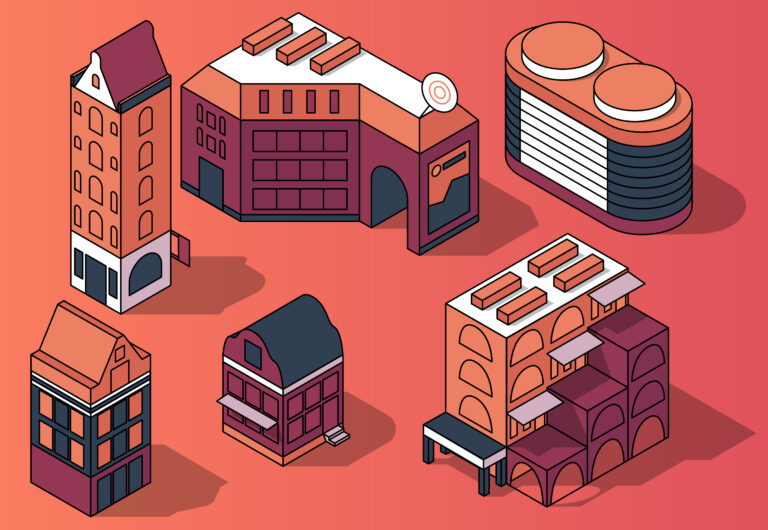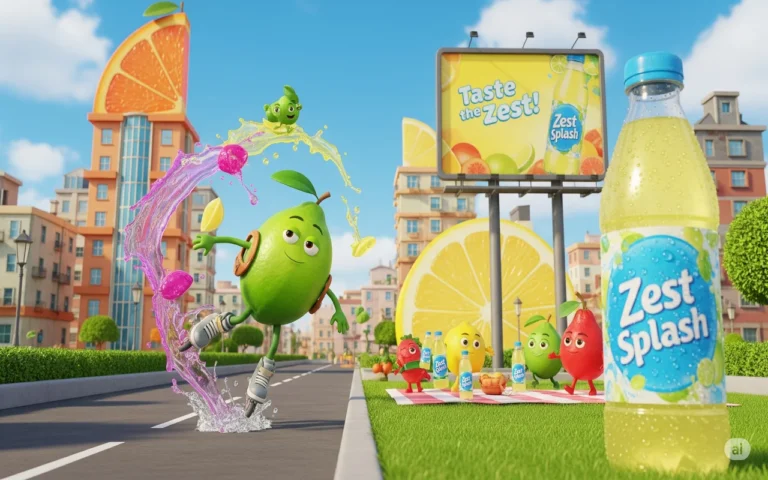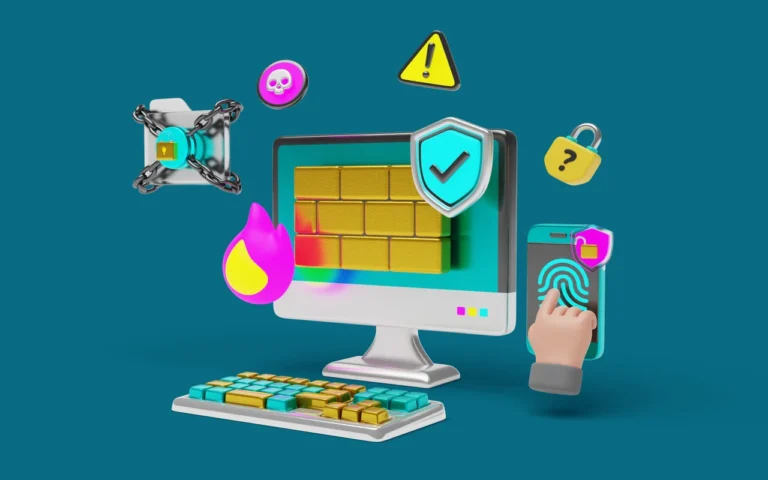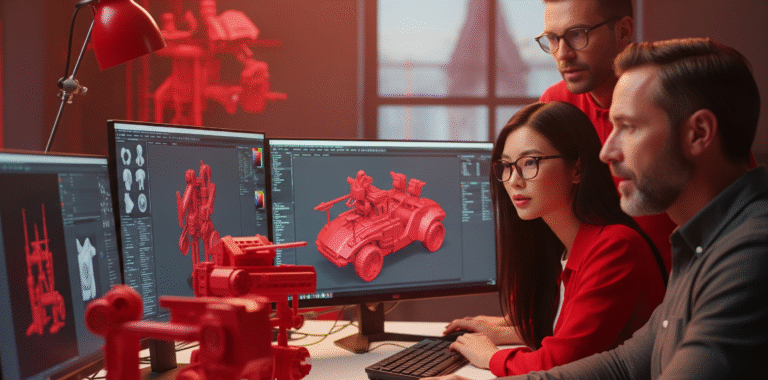Hard surface modeling is a fundamental aspect of 3D animation, used to create everything from sci-fi settings to the smooth roundings of a sports car.
Whether creating assets for games, films, or product design, mastering this skill allows you to build accurate, mechanical, and functional objects.
In this guide, we will explain what hard surface modeling entails, how it contrasts with organic modeling, the key techniques involved, and its applications in the industry.
Let’s explore how experts tackle this skill today!

Need 3D Animation Services?
Visit our 3D Animation Service page to see how we can help bring your ideas to life!
What Exactly Is Hard Surface Modeling?
Hard surface modeling involves creating rigid and mechanical 3D objects, such as vehicles, weapons, buildings, and machinery.
In contrast to organic modeling, which deals with natural shapes, hard surface modeling emphasizes sharp edges, smooth surfaces, and precise geometry. This technique enables artists to create convincing designs that appear functional in both realistic and fictional settings.
From lifelike product renderings to stylized sci-fi assets, hard surface modeling is a cornerstone of contemporary 3D production. Learning hard surface modeling and its principles is key to becoming a well-rounded 3D artist.
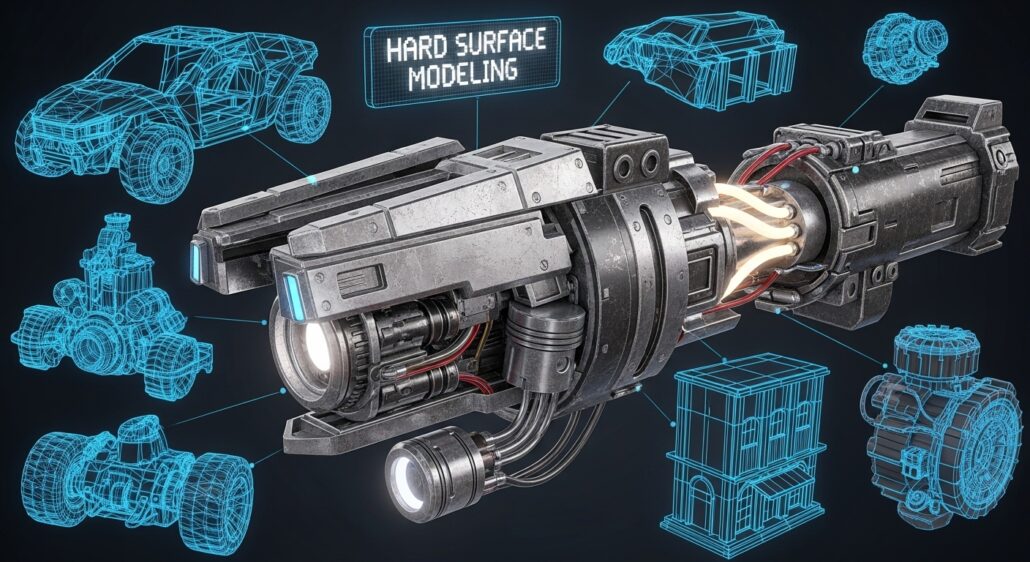
What’s the Difference Between Hard Surface Modeling and Organic Modeling?
3D modeling has two classifications, including organic surface modeling and hard surface modeling.
These two modeling techniques have unique features and applications that we will discuss in the following. However, most studios combine both techniques to craft immersive, believable worlds:
Hard Surface Modeling
Hard surface modeling centers on creating man-made objects with precise structures and defined surfaces, such as vehicles in games like Forza Horizon or weapons in Call of Duty.
These models prioritize accuracy, sharp edges, and a sense of engineered design. The process often involves polygonal modeling, subdivision surfaces, or kitbashing to construct mechanical details efficiently.
Clean and optimized topology is crucial for hard surface models to perform well in real-time engines, requiring careful planning.
Organic Modeling
In contrast, organic modeling focuses on natural, fluid forms like characters, creatures, and landscapes.
It employs sculpting tools, dynamic topology, and subdivision techniques to replicate the organic irregularities of living things.
Games like The Last of Us or films like Avatar use organic modeling to create lifelike faces and creatures.
Unlike the precise lines of hard surface modeling, organic modeling emphasizes subtle curves, muscle flow, and surface variation.
Of course, others may consider hard surface modeling services to be rougher and do not require an organic surface to have a clean topology. But you need a clean topology regardless of what you are modeling.
What Are the Main Techniques in Hard Surface Modeling?
Here we will cover seven modeling techniques. However, note that 3D modeling techniques are limitless, and you should apply each of them to your modeling to find out how they can help you.
Box Modeling
Box modeling begins with a basic shape like a cube or cylinder, which is refined through extrusion, scaling, and subdivision. It’s a beginner-friendly technique widely used by professionals for creating initial blockouts.
Box modeling excels in crafting vehicles, props, and architectural assets, where accurate proportions are prioritized before adding intricate details.
NURBS Modeling
NURBS (Non-Uniform Rational B-Splines) modeling produces mathematically precise surfaces, ideal for product design and automotive visualization, where exact curves are critical for manufacturing.
Although less suited for game assets, NURBS are essential in industries such as CAD and industrial design.
Polygonal Modeling
Polygonal modeling forms the core of most game-ready assets. Artists shape vertices, edges, and faces to build detailed, efficient meshes for real-time engines like Unity or Unreal Engine.
This method offers precise topology control, making it a standard in game and VFX production.
Kitbashing
Kitbashing speeds up workflows by combining pre-existing components, such as bolts, vents, or panels, into new designs.
It’s a go-to for concept artists and 3D modelers facing tight deadlines. Tools like Blender’s Kit Ops or 3D asset libraries make kitbashing key for rapid prototyping.
Subdivision Modeling
Subdivision modeling smooths polygonal meshes by splitting them into smaller faces, creating rounded or beveled edges.
It’s perfect for both stylized and realistic assets like sci-fi armor, vehicles, or props. Clean topology is essential to prevent artifacts during subdivision.
Trim Sheets
Trim sheets enable artists to add repeating details, such as grooves, bolts, or patterns, via texturing instead of geometry.
This approach optimizes game assets while preserving visual depth, making it a staple for AAA game studios to create detailed yet efficient environments.
Edge Loops
Edge loops guide the flow of geometry across a mesh, aiding in subdivision and deformation control.
In hard surface modeling, they ensure sharp edges, support bevels, and maintain clean surfaces. Strategic edge loop placement is critical for achieving crisp corners versus uneven ones.
CSG (Constructive Solid Geometry)
CSG modeling constructs objects by adding or subtracting shapes, like carving a cylindrical hole from a cube.
Common in CAD and used for rapid level prototyping in game engines, it’s less suited for final assets but valuable for early design stages.
Read More: 3D Modeling vs. Sculpting
Where Is Hard Surface Modeling Used?
Hard surface modeling is ubiquitous in digital production:
- In video games, it shapes weapons, vehicles, and interactive environments.
- In films, it brings to life spaceships, robots, and futuristic cities.
- Product designers use it to create realistic renderings of phones, watches, and cars.
- Architects employ it for buildings and interior designs.
- Industries like VR/AR and 3D printing also rely on precise hard surface models.
3D modeling services, tough surface modeling is used in many industries, including vehicle design, product design, architecture, jewelry, industrial design, prop design, virtual worlds, engineering, medicine, and robotics.
Its ability to create precise forms is heavily utilized in many industries, including game art and 3D animation services, as well as medical and engineering applications. It is used to add modifications to an imported model, create more complicated shapes, and draft or make a fillet between faces.
With the ongoing advancements in 3D modeling software and techniques, hard surface modeling will continue to gain prominence as industries strive to digitize and visualize products and concepts with greater accuracy.
What Are the Free Resources to Learn Hard Surface Modeling
Mastering hard surface modeling doesn’t demand costly courses.
- You can use free resources like Blender’s official tutorials, YouTube channels such as ChamferZone and CG Geek, and communities on ArtStation and Polycount to gain access to free learning opportunities.
- Moreover, forums offer free models and critique threads, helping beginners improve rapidly with feedback.
- Open-source tools like Blender provide comprehensive toolsets for polygonal and subdivision modeling at no cost.
- Try platforms such as Gnomon or FXPHD if you’re looking for affordable mini-trainings.
With regular practice and participation in online challenges, anyone can develop a solid foundation in hard surface modeling.
Final Words
Hard surface modeling is the art that blends creativity and technical accuracy, making it essential in the entertainment and design fields.
By learning techniques such as box modeling, subdivision, and kitbashing, artists can craft assets that are both convincing and visually impressive.
Whether aiming for a career in games, film, or product design, proficiency in hard surface modeling unlocks opportunities across various creative industries. With the basics understood, it’s time to practice, explore, and elevate your 3D designs to new heights!
FAQs
Why avoid committing too early in the modeling process?
Stay flexible in shape and form early on, allowing room for exploration and avoiding premature mistakes.
Do I need add-ons for hard surface modeling?
No, while add-ons can speed things up, mastering topology and core tools is most essential.
What industry uses hard surface modeling?
Widely used in game dev, film, product design, mechanical modeling, and architectural visualization.
Do artists work with separate parts or one mesh?
Yes. Modelers often break objects into parts (subtools) to manage complexity and detail.
Should I bake high-res detail onto a low-poly model?
Absolutely. Create a low-poly mesh and bake high-res details (normals, textures) for efficiency.
How tidy should topology be?
Use clean, organized topology: avoid unnecessary edges, n-gons, and odd triangulation. Every vertex should serve a purpose.
What’s the best practice for edge loops and poly flow?
Be conservative with edge loops; manually adjust edges to ensure a clean, four-sided mesh and avoid artifacts.
How do I begin modeling complex hard-surface scenes?
Start by blocking out shapes using basic geometry to establish scale, composition, and functionality early.
How important is reference for hard-surface modeling?
Critical. Study how designs work in real life, ideally using blueprints or technical reference to guide realism.
